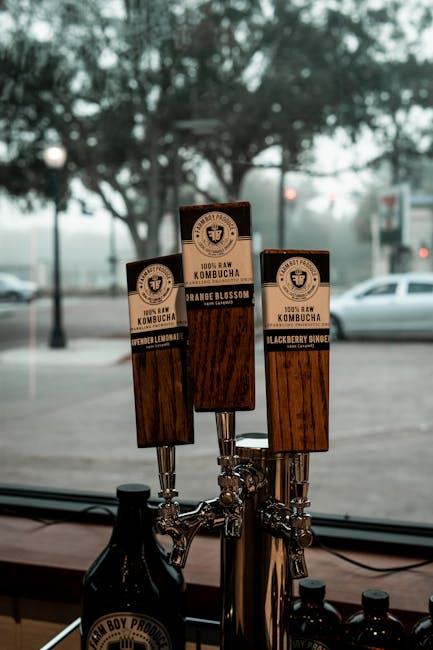In the world of fermented drinks, there’s a process that adds a whole new level of flavor and fizz – the enchanting realm of kombucha second fermentation. Just when you thought this ancient elixir couldn’t get any better, along comes this innovative technique to take your kombucha experience to soaring new heights. Join us as we delve into the captivating world of kombucha second fermentation, where bubbling creativity meets tantalizing taste sensations.
Table of Contents
- Mastering the Art of Flavor Infusion in Kombucha Second Fermentation
- Unlocking the Science Behind Achieving Optimal Carbonation
- Expert Tips for Selecting the Best Ingredients for Second Fermentation
- Elevate Your Kombucha Game with Creative Bottling and Storage Techniques
- Q&A
- Concluding Remarks
Mastering the Art of Flavor Infusion in Kombucha Second Fermentation
The key to elevating your kombucha to a whole new level lies in mastering the art of flavor infusion during the second fermentation process. By experimenting with various ingredients and techniques, you can create a symphony of flavors that will tantalize your taste buds and leave you craving for more.
**Here are some creative tips to help you unlock the full potential of your kombucha during the second fermentation:**
- **Mix and Match**: Pair different fruits, herbs, and spices to create unique flavor combinations.
- **Timing is Everything**: Experiment with the duration of fermentation to achieve the perfect balance of sweetness and tartness.
- **Temperature Control**: Optimal fermentation temperatures can greatly impact the flavor profile of your kombucha.


Unlocking the Science Behind Achieving Optimal Carbonation
Exploring the realm of kombucha second fermentation unveils a fascinating journey of discovering the art and science behind achieving the perfect level of carbonation. When delving into the intricate process of creating effervescent kombucha, understanding the factors influencing carbonation becomes paramount.
With a blend of precise timing, meticulous ingredient selection, and a touch of experimentation, kombucha enthusiasts can unlock the secret to mastering optimal carbonation levels. Harnessing the power of yeast and sugar interactions, coupled with the right brewing environment, allows for the creation of bubbly, crisp kombucha that tantalizes the taste buds. Embracing the nuances of second fermentation can elevate the kombucha experience to new heights, offering a sensory delight with each effervescent sip.


Expert Tips for Selecting the Best Ingredients for Second Fermentation
When it comes to enhancing the flavor and fizz of your homemade kombucha during the second fermentation process, choosing the right ingredients is key. To level up your brew and create unique flavor profiles, consider these expert tips for selecting the best ingredients:
- Fresh Fruits: Add a burst of natural sweetness and vibrant flavors by incorporating fresh fruits like berries, citrus slices, or tropical fruits into your kombucha.
- Herbs and Spices: Infuse depth and complexity by experimenting with herbs and spices such as mint, ginger, lavender, or cinnamon sticks.
- Botanicals: Elevate your brew with floral notes by using petals from edible flowers like hibiscus, chamomile, or rose.
Additionally, consider incorporating a combination of ingredients to create unique flavor combinations that will delight your taste buds. Whether you prefer a zesty citrus blend or a soothing herbal infusion, the possibilities are endless when it comes to crafting your perfect second fermentation concoction.
| Ingredient | Flavor Profile |
|---|---|
| Fresh Berries | Fruity and Refreshing |
| Ginger & Turmeric | Spicy and Earthy |
| Lavender & Vanilla | Floral and Sweet |


Elevate Your Kombucha Game with Creative Bottling and Storage Techniques
Ready to take your kombucha brewing to the next level? Explore the world of second fermentation and unleash a symphony of flavors by experimenting with creative bottling and storage techniques. Elevate your kombucha game and surprise your taste buds with these innovative methods that will bring a new dimension to your homemade brew.
**Transform your kombucha into a work of art with these unique ideas:**
- **Layered Flavors**: Experiment with infusing different fruits, herbs, and spices in separate layers for a visually stunning and delicious brew.
- **Sparkling Elixirs**: Add a touch of effervescence by opting for airtight bottles and allowing carbonation to build up during fermentation.
- **Decorative Labels**: Personalize each bottle with quirky labels and designs to make your kombucha not only a treat for the taste buds but also for the eyes.
| Flavor Combinations | Ingredients |
|---|---|
| Spiced Citrus Explosion | Oranges, Cinnamon, Cloves |
| Tropical Paradise | Pineapple, Mango, Coconut |
Q&A
—Q&A: Unlocking the Magic of Kombucha Second Fermentation
Q1: What is kombucha second fermentation and why is it so special?
A: Kombucha second fermentation is the alchemical process where kombucha tea undergoes a secondary fermentation after the initial brewing. This process elevates the flavor profiles and enhances the effervescence of your favorite bubbly brew, making it a truly magical experience for your taste buds.
Q2: How long should I let my kombucha ferment during the second fermentation stage?
A: The duration of the second fermentation can vary depending on your taste preferences. Typically, letting your kombucha ferment for 3 to 5 days at room temperature can result in a well-balanced and fizzy brew. However, some kombucha enthusiasts prefer a longer fermentation period for a stronger flavor punch.
Q3: What are the best ingredients to use for flavoring during the second fermentation?
A: The beauty of kombucha second fermentation lies in the endless possibilities for flavor experimentation. From fresh fruits like berries and citrus to herbs and spices like ginger and mint, the choices are limited only by your imagination. Get creative and have fun concocting unique flavor combinations that resonate with your palate.
Q4: Can I use glass bottles for the second fermentation, and why are they recommended?
A: Glass bottles are highly recommended for the second fermentation due to their non-reactive nature and ability to contain the carbonation produced during the process. Unlike plastic containers, glass bottles do not impart any unwanted flavors into your kombucha and are safe for retaining the fizziness of your brew.
Q5: How can I ensure that my kombucha is safe to drink after the second fermentation?
A: To ensure the safety of your kombucha post-second fermentation, it is crucial to look out for signs of carbonation such as bubbles, as well as taste and aroma. The pH level should be around 2.5 to 3.5 to prevent the growth of harmful bacteria. Trust your senses and if everything seems and tastes right, your homemade kombucha is good to go!
Unlock the secrets of kombucha second fermentation and delve into a world of flavor and fizz with each delightful sip. Cheers to the art of crafting your own effervescent elixir at home!
—
Concluding Remarks
As you embark on your journey into the world of kombucha second fermentation, remember that experimentation is key. The beauty of this process lies in its endless possibilities and the opportunity to create unique flavors that tantalize your taste buds. Whether you’re a kombucha connoisseur or a curious beginner, the magic of second fermentation is sure to captivate you.So, go ahead and play with fruits, herbs, and spices to craft your own signature brew. Embrace the fizz, the tang, and the complexity that each batch brings. Cheers to endless flavor combinations and the joy of sipping on your very own homemade kombucha creations. With each bottle, you’re not just fermenting tea – you’re fermenting creativity.
Stay inspired, stay adventurous, and most importantly, stay bubbly. The world of kombucha second fermentation awaits, ready to spark your imagination and elevate your taste experience. Here’s to the exciting journey ahead – happy brewing!
[elementor-template id=”28″]